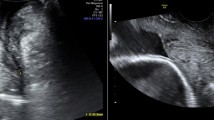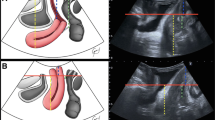Abstract
Introduction and hypothesis
Cervical elongation (CE) has not been clearly defined and has similar symptoms to pelvic organ prolapse. We aimed to evaluate the diagnostic value of preoperative POP-Q examinations, ultrasonographic measurements, and direct cervical length measurement with a Foley catheter in predicting CE on postoperative hysterectomy specimens.
Methods
Fifty-six patients who underwent vaginal hysterectomy for apical pelvic organ prolapse were included. The patients were divided into two groups based on the hysterectomy specimens’ corpus/cervix ratio (CCR) as follows: the non-CE group, CCR > 1; the CE group, CCR < 1. The preoperative direct cervical length measurement was performed using 10-French Foley catheters. The recommended cutoff values and sensitivity/specificity analysis of the cervical measurements with Foley, ultrasound, and C-D measurements according to POP-Q were determined by the receiver-operating characteristic analysis.
Results
There were 13 patients (23%) in the non-CE group and 43 patients (76%) in the CE group. The mean cervical measurements with Foley catheter and ultrasound, C-D diameter, and postoperative cervix measurements were 49.4 ± 12.6 mm, 42.14 ± 9.4 mm, 41.4 ± 17.2 mm, and 49.5 ± 13 mm, respectively. Cervical measurement with a Foley catheter had 65% sensitivity and 62.5% specificity with a 47.5-mm cutoff value. Among these preoperative measurements, Foley catheter measurements were the most compatible with postoperative cervical measurements. There was no significant association between CE and age, body mass index, menopause duration, point C, and point D.
Conclusion
Cervical length measurement with a Foley catheter may be preferred for estimation of CE.



Similar content being viewed by others
References
Okonkwo JE, Obiechina NJ, Obionu CN. Incidence of pelvic organ prolapse in Nigerian women. J Natl Med Assoc. 2003;95:132–6.
Diwan A, Rardin CR, Kohli N. Uterine preservation during surgery for uterovaginal prolapse: a review. Int Urogynecol J Pelvic Floor Dysfunct. 2004;15:286–92. https://doi.org/10.1007/s00192-004-1166-4.
Lin TY, Su TH, Wang YL, Lee MY, Hsieh CH, Wang KG, et al. Risk factors for failure of transvaginal sacrospinous uterine suspension in the treatment of uterovaginal prolapse. J Formos Med Assoc. 2005;104:249–53.
Vierhout ME, Futterer JJ. Extreme cervical elongation after sacrohysteropexy. Int Urogynecol J. 2013;24:1579–80. https://doi.org/10.1007/s00192-012-1939-0.
Hyakutake MT, Cundiff GW, Geoffrion R. Cervical elongation following sacrospinous hysteropexy: a case series. Int Urogynecol J. 2014;25:851–4. https://doi.org/10.1007/s00192-013-2258-9.
Thys SD, Coolen A, Martens IR, Oosterbaan HP, Roovers J, Mol B, et al. A comparison of long-term outcome between Manchester-Fothergill and vaginal hysterectomy as treatment for uterine descent. Int Urogynecol J. 2011;22:1171–8. https://doi.org/10.1007/s00192-011-1422-3.
Dancz CE, Werth L, Sun V, Lee S, Walker D, Özel B. Comparison of the POP-Q examination, transvaginal ultrasound, and direct anatomic measurement of cervical length. Int Urogynecol J. 2014;25:457–64. https://doi.org/10.1007/s00192-013-2255-z.
Berger MB, Ramanah R, Guire KE, DeLancey JO. Is cervical elongation associated with pelvic organ prolapse? Int Urogynecol J. 2012;23(8):1095–103. https://doi.org/10.1007/s00192-012-1747-6.
Mothes AR, Mothes H, Fröber R, Radosa MP, Runnebaum IB. Systematic classification of uterine cervical elongation in patients with pelvic organ prolapse. Eur J Obstet Gynecol Reprod Biol. 2016;200:40–4. https://doi.org/10.1016/j.ejogrb.2016.02.029.
Finamore PS, Goldstein HB, Vakili B. Comparison of estimated cervical length from the pelvic organ prolapse quantification exam and actual cervical length at hysterectomy: can we accurately determine cervical elongation? Journal of Pelvic Medicine and Surgery. 2009;15:17–9. https://doi.org/10.1097/SPV.0b013e3181951e98.
Nosti PA, Gutman RE, Iglesia CB, Park AJ, Tefera E, Sokol AI. Defining cervical elongation: a prospective observational study. J Obstet Gynaecol Can. 2017;39:223–8. https://doi.org/10.1016/j.jogc.2016.10.012.
Williams KS, Rosen L, Pilkinton ML, Dhariwal L, Winkler HA. Putting POP-Q to the test: does C - D = cervical length? Int Urogynecol J. 2018;29:881–5. https://doi.org/10.1007/s00192-017-3464-7.
Ibeanu OA, Chesson RR, Sandquist D, Perez J, Santiago K, Nolan TE. Hypertrophic cervical elongation: clinical and histological correlations. Int Urogynecol J. 2010;21:995–1000. https://doi.org/10.1007/s00192-010-1131-3.
Hsiao SM, Chang TC, Chen CH, Li YI, Shun CT, Lin HH. Risk factors for coexistence of cervical elongation in uterine prolapse. Eur J Obstet Gynecol Reprod Biol. 2018;229:94–7. https://doi.org/10.1016/j.ejogrb.2018.08.011.
Author information
Authors and Affiliations
Corresponding author
Ethics declarations
Conflicts of interest
None.
Consent
Written informed consent was obtained from the patient for publication of these images in an article.
Additional information
Publisher’s note
Springer Nature remains neutral with regard to jurisdictional claims in published maps and institutional affiliations.
Rights and permissions
About this article
Cite this article
Alay, I., Kaya, C., Karaca, I. et al. Diagnostic value of preoperative ultrasonography, cervical length measurement, and POP-Q examination in cervical elongation estimation. Int Urogynecol J 31, 2617–2623 (2020). https://doi.org/10.1007/s00192-020-04426-x
Received:
Accepted:
Published:
Issue Date:
DOI: https://doi.org/10.1007/s00192-020-04426-x




